1961 saw the birth of one of the most important and beautiful architectonical projects created in the Revolutionary Cuba: the Cubanacán National Schools of Arts, located at one of the favorite sites of wealthy Cubans, the Havana Country Club terrains. The vanguard proposal, as well as a series of internal conflicts led to the astonishing conclusion that the design of the buildings had a bourgeois reminiscence. So, with the excuse of a lack of resources, the construction was stopped in 1965 and some of the schools were never finished.
I am telling this story just as an example on how the revolutionary government couldn’t build almost any new architectonical valuable structure to host the avalanche of newly created institutions, and in consequence had to occupy those inherited.
 |
| Celia-Yunior, Epiphytes Colonies, digital photo, 1x1.50 m, (2012 - ongoing) |
Cuba is a nation where the present is legislated through antique (and antiquated) administrative structures. From this side, there is an apparent incapacity of creating new ones, both physically (in form of new buildings) and relationally (channels that foster the interaction between the bureaucracy and the people). Administration tries to get by this incapacity through archiving historic occurrences in a very particular manner. This is also symptomatic as it reveals a method to convert access to power in a tedious process. And as Boris Groys states, in these biopolitical conditions, art may assume the same procedures.
The duo Celia-Yunior[1] considers that there is a divergence between the needs of any human being and the structures that have been created in order to manage those needs. They are mostly interested in “how these ways of managing life in society become contradictory, once the individual starts reformulating them, in order to use them for his/her own interest”.
In their work Epiphytes Colonies (2012-ongoing), they use the main characteristic of the epiphytes as a metaphor of this behavior, being the epiphytes plants that grow harmlessly upon another plant in order to gain physical support, not necessarily negatively affecting the host.
 |
| Celia-Yunior, Passport, 11 passports from XIX - XX century and Law Decree No. 32 (2013 - ongoing) |
In some of their works, the artists have mimicked the aesthetics of a historic document through installations that take the form of statistics or albums. Epiphytes Colonies is until now composed by 28 scanned album pages, as an outcome of a research process. The artists seek for those old mansions that changed their prime function as households to become the host of some governmental organization. But as usual, the architecture materializes the power. Every mansion expresses the financial status of the original owners (all of them being part of the higher layers of the society during the Republican Period (1902-1959)) and thus represents all that the Revolution tried to eradicate: social differences, abuse of power, capitalism. But these “aesthetics of a past power” (as Celia-Yunior calls it) is usurped and used on the own favor as a mirage.
The final presentation of Epiphytes Colonies is conceived as one single body of work where each element may also act independently. The work contains a principle of authorship, that makes itself visible by the way how the subject is selected and considered relevant, and a principle of representation, by the way how the topic is depicted. And as in an ordinary personal album, the artists take a picture (of the mansion), and provide the information by hand written texts (the data of the ancient and current inhabitants).
In Passport (2013-ongoing), here in collaboration with Miguel Hernández, Celia-Yunior use a similar process. The work is comprised until now by eleven rescued passports dating from the XIX century and the beginning of XX. The interest here is in how the artists confront constitutional social rights of the past and the present through the simple correlation of statutes. In 2013 the Cuban Government issued Law No.32 in which the possibility of travelling abroad without restrictions (on their side) was announced as novelty. By displaying the passports (belonging to a forgotten past) along with the new law, they show a point of rupture in the continuity of Cuban history. Something is presented as new, although it is just the act of giving back something that was taken in first place.
Recovering those historical records that are not considered historically relevant, and decoding historical events under the filter of contemporaneity, helps filling those gaps in the History. Celia and Yunior, with their vocation for research, reexamine official Cuban archives and questions their legitimacy. A much needed gesture in the current circumstances.
----
[1] Celia González (1985) and Yunior Aguiar (1984), work as an artistic duo since 2004. Both artists graduated from the University of Arts in 2009 and the Behavior Art School in 2006. The duo was awarded last year with the first International Cuban Art Award prize for Young Artists, sponsored by the Farber Foundation, and was among the selected artists for the Cuban Pavilion in last Venice Biennale.


